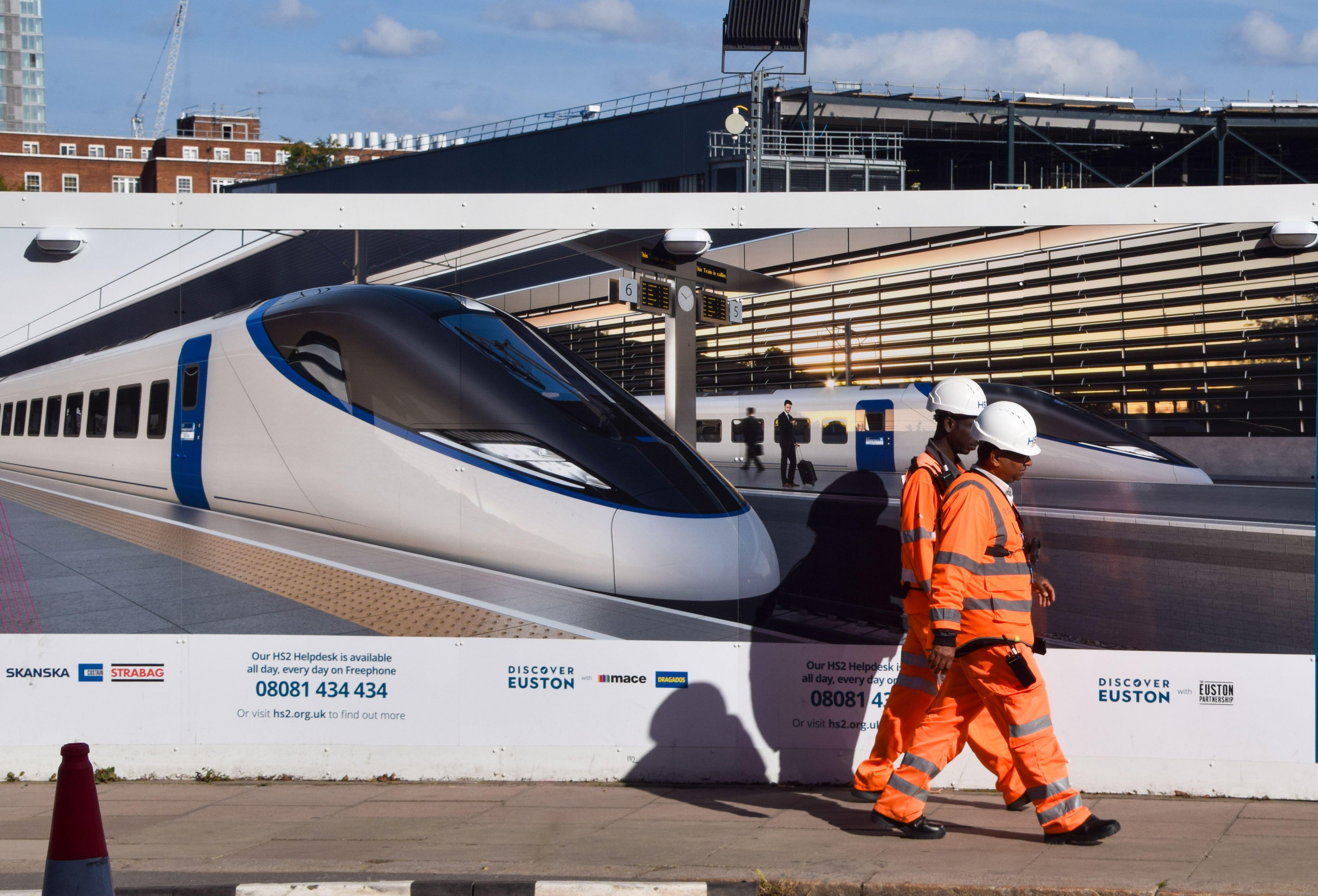Reviving Britain’s Infrastructure: The Case for PFIs in Transport Projects
The expansive 60-acre area adjacent to Euston station in London was expected to be bustling with construction work by this time. Crews should have been erecting platforms and implementing advanced signaling systems for trains capable of traveling at 225 mph. Yet, last Friday morning, the HS2 railway terminus site appeared mostly abandoned, with only a handful of workers in high-visibility jackets present. Others were seen idly looking at their phones near a Caffè Nero, while overgrown grass reached heights exceeding 3 feet amid the debris.
Nevertheless, behind-the-scenes efforts aim to prevent this site from becoming HS2’s largest failure, planning instead to revive elements of the contentious public finance initiative (PFI).

According to sources, senior officials from the Department for Transport are developing a strategy to attract over £3 billion from private investors to finance both the new HS2 station at Euston and the necessary renovations of the aging mainline terminal nearby. This initiative mirrors key aspects of the PFI model, which was prominent during Tony Blair’s administration, where private sector funding is utilized for public projects in exchange for long-term repayments.
Last August, it was reported that Chancellor Rachel Reeves was also considering a PFI-style arrangement to address the £9 billion costs of the Lower Thames Crossing, a significant road tunnel project to the east of London.

In light of constrained public finances and the urgent need for investment to stimulate economic recovery, the potential reintroduction of PFIs is gaining traction, albeit it remains a controversial approach.
PFIs were terminated in 2018 due to concerns regarding their cost-effectiveness for taxpayers, with numerous astonishing anecdotes highlighting the issues. For instance, one PFI-run hospital was reported to have charged over £300 for a single lightbulb replacement, while a Bromley hospital, which had construction costs of £118 million, is anticipated to cost taxpayers around £1.2 billion throughout the contract’s term. Currently, about £52 billion worth of PFI contracts are still active.
If the government moves forward with renewed PFI-style agreements, how can it mitigate the failures of the past?
The PFI concept originated in the early 1990s when Prime Minister John Major sought private sector efficiency in public contracts. PFIs often finance infrastructure projects, including public services such as educational institutions and hospitals. The mechanism involves establishing a special purpose vehicle (SPV) to borrow funds for construction. Subsequently, taxpayers make payments to the SPV over a designated period of about 25 to 30 years, covering debt repayment, financing, and maintenance expenditures.
Transport officials believe that implementing a modern version of this approach could tackle some of the rail industry’s most intricate challenges.

There have been plans for over a decade to redevelop Euston’s mainline station, serving Avanti trains to cities like Birmingham, Manchester, and Glasgow, and to construct HS2’s primary station in London. However, following Prime Minister Rishi Sunak’s decision to downscale HS2 investments last fall, favoring smaller transport projects deemed more financially responsible, the development has reached a standstill. An insider remarked, “It’s a really complex jigsaw.”
Transport officials are seeking Treasury approval to initiate a tender, allowing private investors to secure a long-term concession for the two stations.
Private investors are expected to contribute at least £3 billion to cover the renovation of the mainline station and the construction of the HS2 station, receiving payments based on passenger numbers over a specified duration. The government would likely inject around £700 million, according to sources close to the Department for Transport.
The proposals remain in development and hinge on the Treasury’s endorsement of public funds to construct a 4.5-mile tunnel linking Euston to Old Oak Common, a station in west London designated for HS2 services, which carries an estimated price tag of £1 billion. Transport Secretary Louise Haigh has signaled that approval for the tunnel is forthcoming.
A definitive decision on employing a PFI-style model for Euston is not anticipated until next spring’s spending review, which will also clarify plans for the Lower Thames Crossing, intended to connect Kent and Essex through a tunnel beneath the Thames.
“We are reviewing the inherited position on HS2 and will announce a strategy in due course,” stated a government representative. The PFI model, which saw widespread application under New Labour in the late 1990s and 2000s, facilitated the construction of new hospitals and schools.
Paul Davies, an advisor with expertise in infrastructure and government contracts, contends that PFIs can drive value compared to standard government procurement, transferring some risk to the private sector. By establishing exact specifications upfront, PFIs aim to prevent costly changes during larger projects, as Davies elaborated.
However, the fragility of PFIs, often financed through debt, was laid bare during the 2008 credit crunch, prompting the government to scale back their usage. This led to the creation of PF2, which aimed to enhance transparency concerning private financial returns following a Treasury review.
Unfortunately, as departmental budgets tightened, the dynamic between the government and private partners turned confrontational.
Government entities sought to minimize performance-related payment deductions, provoking pushback from companies already grappling with their financial issues.
This resulted in absurd instances where local authorities and companies manipulated contractual technicalities for payment rights over trivial matters. For instance, in 2019, Birmingham council pursued engineering firm Amey for £48 million in penalties related to the failure to install four road bollards.
The termination of new PFI or PF2 contracts in 2018 by Chancellor Hammond occurred after Carillion’s collapse led to a five-year postponement of the £335 million Royal Liverpool Hospital’s opening, which was being constructed under a PFI agreement. Earlier that year, the National Audit Office revealed minimal evidence supporting lower construction costs under PFIs. Hammond stated, “the public sector can no longer be a pushover.”
However, this termination only pertained to new PFIs while older contracts endured, with 669 still operational, some expiring as late as 2048, covering a wide array of services. Unexpectedly, the M25 has operated under a 30-year PFI since 2009, funding enhancements and maintenance costs. A consortium comprising seven investors, including construction giant Balfour Beatty and Chicago’s Grosvenor Capital Management, earned £43 million in dividends last year.
Labour’s willingness to revisit PFIs coincides with a growing backlog of infrastructure projects. The Lower Thames Crossing has sought funding for several years, and a PFI for this initiative was nearly finalized before Hammond’s 2018 cuts. The Stonehenge tunnel scheme, aimed at easing A303 congestion, faced cancellation earlier this July after protracted discussions.
Alistair Watson, an environmental planning expert at Taylor Wessing law firm, asserts that a significant infrastructure renewal program has been overdue. “With each passing year of insufficient infrastructure, the demand continuously escalates,” he remarked.
Nevertheless, Watson and Davies suggested that the troubling era of PFIs would not resurface. They predict that new PFIs will foster a collaborative relationship where the government underwrites expenses and holds equity stakes in projects. With contractors less apprehensive about unfavorable contracts, exorbitant charges are anticipated to diminish. The intricate legacy of PFIs, combined with the government’s strained finances, will necessitate innovative solutions in Westminster. Without such creativity, the long-awaited high-speed trains may never arrive at Euston station.






